
Benito Pablo Juárez García was a Mexican politician, military commander, and lawyer who served as the 26th president of Mexico from 1858 until his death in office in 1872. Of Zapotec ancestry, he was the first indigenous president of Mexico and the first democratically elected indigenous president in the postcolonial Americas. A member of the Liberal Party, he previously held a number of offices, including the governorship of Oaxaca and the presidency of the Supreme Court. During his presidency he led the Liberals to victory in the Reform War and in the Second French intervention in Mexico.

Miguel Gregorio de la Luz Atenógenes Miramón y Tarelo, known as Miguel Miramón, was a Mexican conservative general who disputed the Mexican presidency with Benito Juarez at the age of twenty seven during the Reform War, serving between February 1859 and December 1860. He was the first Mexican president to be born after the Mexican War of Independence.
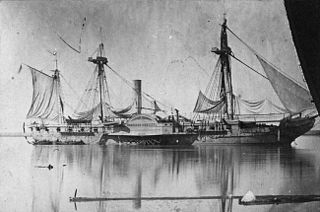
The Home Squadron was part of the United States Navy in the mid-19th century. Organized as early as 1838, ships were assigned to protect coastal commerce, aid ships in distress, suppress piracy and the Atlantic slave trade, make coastal surveys, and train ships to relieve others on distant stations. It was discontinued in 1861 after the outbreak of the American Civil War, when the Union blockade forced a reassignment of ships to close off Southern ports.

Félix María Zuloaga Trillo (1813–1898) was a Mexican conservative general and politician who played a key role in the outbreak of the Reform War in early 1860, a war which would see him elevated to the presidency of the nation. President Zuloaga was unrecognized by and fought against the liberals supporters of President Benito Juarez.
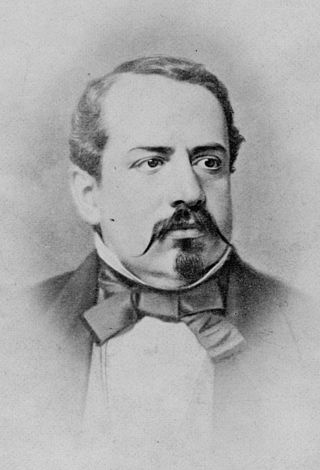
Manuel Robles Pezuela was a military engineer, military commander, and eventually interim president of Mexico during a civil war, the War of Reform, being waged between conservatives and liberals, in which he served as president of the Conservatives, in opposition to President Benito Juarez, head of the Liberals.

José Mariano Salas Barbosa was a Mexican soldier and politician who served twice as interim president of Mexico, once in 1846, during the Mexican American War, and once in 1859 during the War of Reform.
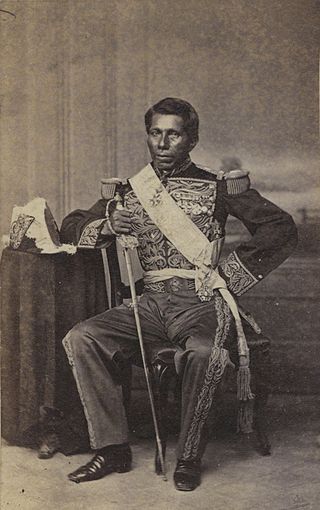
José Tomás de la Luz Mejía Camacho, better known as Tomás Mejía, was a Mexican soldier of Otomi background, who consistently sided with the Conservative Party throughout its nineteenth century conflicts with the Liberals.
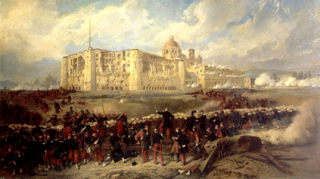
The second French intervention in Mexico, also known as the Second Franco-Mexican War (1861–1867), was a military invasion of the Republic of Mexico by the French Empire of Napoleon III, purportedly to force the collection of Mexican debts in conjunction with Great Britain and Spain. Mexican conservatives supported the invasion, since they had been defeated by the liberal government of Benito Juárez in a three-year civil war. Defeated on the battlefield, conservatives sought the aid of France to effect regime change and establish a monarchy in Mexico, a plan that meshed with Napoleon III's plans to re-establish the presence of the French Empire in the Americas. Although the French invasion displaced Juárez's Republican government from the Mexican capital and the monarchy of Archduke Maximilian was established, the Second Mexican Empire collapsed within a few years. Material aid from the United States, whose four-year civil war ended in 1865, invigorated the Republican fight against the regime of Maximilian, and the 1866 decision of Napoleon III to withdraw military support for Maximilian's regime accelerated the monarchy's collapse. Maximilian and two Mexican generals were executed by firing squad on 19 June 1867, ending this period of Mexican history.
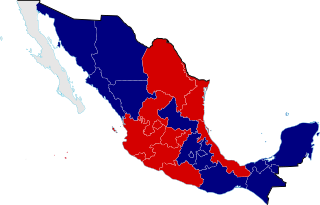
The Reform War, or War of Reform, also known as the Three Years' War, and the Mexican Civil War, was a complex civil conflict in Mexico fought between Mexican liberals and conservatives with regional variations over the promulgation of Constitution of 1857. It has been called the "worst civil war to hit Mexico between the War of Independence of 1810-21 and the Revolution of 1910-20." Following the liberals' overthrow of the dictatorship of conservative Antonio López de Santa Anna, liberals passed a series of laws codifying their political program. These laws were incorporated into the new constitution. It aimed to limit the political power of the executive branch, as well as the political, economic, and cultural power of the Catholic Church. Specific measures were the expropriation of Church property; separation of church and state; reduction of the power of the Mexican Army by elimination of their special privileges; strengthening the secular state through public education; and measures to develop the nation economically.
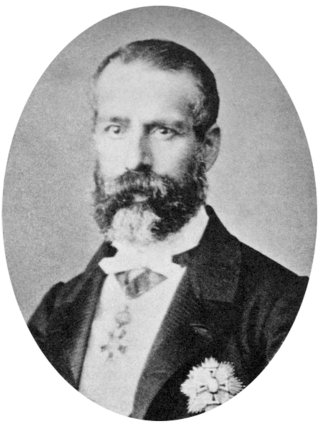
Leonardo Márquez Araujo was a conservative Mexican general. He led forces in opposition to the Liberals led by Benito Juárez, but following defeat in the Reform War was forced to guerrilla warfare. Later, he helped the French in their intervention to help restore the conservative cause. However, their defeat forced him into exile for most of the rest of his life.

José Ignacio María del Corazón de Jesús de Santa Clara Francisco Javier Juan Nepomuceno Antonio de Padua Pavón Jiménez, known as José Ignacio Pavón, was a Mexican civil servant, and briefly, for two days, interim President of Mexico during the final months of a civil war, the War of Reform, being waged between conservatives and liberals, in which he served as president for the Conservatives, in opposition to President Benito Juarez, head of the Liberals.

The Battle of Antón Lizardo was a naval engagement of the Mexican civil war between liberals and conservative governments, the Reform War. It took place off the Gulf Coast town of Antón Lizardo, Mexico in 1860. A Mexican Navy officer, Rear Admiral Tomás M. Marín, mutinied and escaped to Havana, Cuba. There he formed a squadron of armed vessels to attack merchant ships and blockade Veracruz. The liberal Mexican Government of Benito Juárez declared Tomás Marín a pirate and permitted foreign navies to attack his ships. Juárez's government was supported by the United States and its navy already had several vessels patrolling in the Gulf of Mexico.

The Plan of Tacubaya, sometimes called the Plan of Zuloaga, was issued by conservative Mexican General Félix Zuloaga on 17 December 1857 in Tacubaya against the liberal Constitution of 1857. The plan nullified the Constitution while it continued to recognize the election of moderate liberal Ignacio Comonfort as President. Conservatives had fiercely objected to the Constitution of 1857, which abolished special privileges of the Catholic Church and the Mexican Army. President Ignacio Comonfort had not been a strong supporter of the Constitution and joined with Zuloaga, commander of the garrison in Mexico City.
Events in the year 1860 in Mexico. Throughout 1860, Mexico continued a civil war, known as the Mexican Civil War or the Reform War. Two political movements fought for civil control: a reform government led by Benito Juárez and a conservative government led by Miguel Miramón. By 1860, the liberal government under Benito Juárez had emerged victorious in this three-year civil war.

The Siege of Querétaro was the culminating battle of the Second French intervention in Mexico and the Second Mexican Empire. It took place between Republican and Imperial armies from 6 March to 15 May 1867.
The Second Siege of Veracruz was a military encounter of the Reform War which took place around Veracruz, Mexico in 1860. Conservative President Miguel Miramon besieged the Liberal capital, Veracruz, for over a month but was compelled to withdraw after he ran out of ammunition. Part of his problem was that he was unable to blockade the port by sea due to the intervention of the United States off Antón Lizardo.

Juan Díaz Covarrubias was a Mexican writer and poet of liberal ideology. He was one of the Martyrs of Tacubaya who were executed during the War of the Reform in Mexico.
The Battle of Loma Alta took place on April 24, 1860 in the vicinity of Loma Alta in the state of Zacatecas, Mexico, between elements of the liberal army of the National Guard of San Luis Potosí and Zacatecas, under General Jose Lopez Uraga and elements of the conservative army commanded by General Romulo Diaz De La Vega during the War of Reform.

The Battle of Calpulalpan took place on December 22, 1860 during the War of Reform in the vicinity of the community of San Miguel de la Victoria in the municipality of Jilotepec de Abasolo in the State of Mexico, Mexico. It would be the last battle of the War of Reform (1858-1860).
The Battle of Guadalajara (1858) took place on 14 December 1858 in the vicinity of La Hacienda de Atequiza, near the city of Guadalajara in the state of Jalisco, Mexico, during Reform War. Between elements of the liberal army, under General Santos Degollado, and elements of the conservative army commanded by Generals Miguel Miramón, Leonardo Márquez, Marcelino Cobos, the victory went to the conservative side. The conservatives attacked the ranch of San Miguel, near Poncitlán, Jalisco, where the battle took place. By the end of the battle, the conservatives had gained great quantities of weapons and other war materials. Afterwards, Miramón sent orders to shoot the captured liberal officers.















